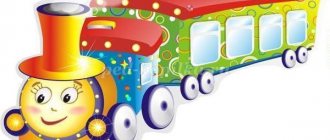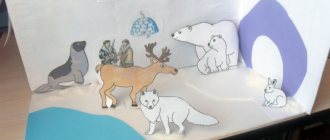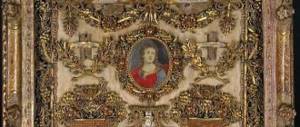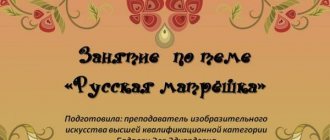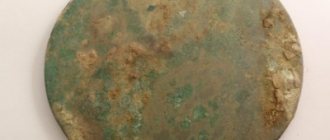Abstract of the educational activity for cognition “The history of the appearance of the light bulb” with children of the sixth year of life
Summary of direct educational activities with children of the senior group of a preschool educational institution on the topic “The history of the appearance of the light bulb”
Author: teacher Logunova Elena Andreevna, 1st category, MDOU “Orsha kindergarten” in the village of Orsha Educational area “Cognitive development” Forms of direct educational activities: joint activities Forms of organization : group Program content: Purpose: To give children an idea of the changes in objects used by humans for lighting in connection with the needs of society and technical progress. Objectives: Educational:
• Help children navigate the past and present of lighting devices, the process of their transformation by man;
• Establish rules for the safe use of electrical appliances; • Create interest in the lives of people in the past. Educational:
• To foster children's cognitive activity and curiosity.
Developmental:
• Develop: a retrospective look at everyday objects, coherent speech.
Enrich and activate vocabulary; creativity, fantasy. Relevance:
Development of cognitive interests of preschool children: is one of the pressing problems of pedagogy, designed to educate a person capable of self-development and self-improvement.
It is especially relevant at the present stage, since it develops children's curiosity, an inquisitive mind and forms, on their basis, stable cognitive interests that are an integral part of school readiness. Dictionary of new words: Svetets, kerosene, electric, base, bulb, filament. Equipment: Illustrations:
“Kerosene Lamp”, “Torch”, “Splinter”, “Bonfire”, “Candle”, portrait of Alexander Ladygin;
Mnemonic diagram:
“Candle”, rope with knots, layouts: cave, castle, black castle of the Queen of Darkness made of paper, black envelope, candles for everyone, electric light bulb;
Laptop: Presentations:
“Luchinushka”, “Kerosene lamp”;
Table lamp; a strip of blue paper - the river of time, a model of a time machine, a lamp - with multi-colored light, musical accompaniment. Preliminary work: • Cognitive: “Human inventions”, “Who are inventors?” Viewing illustration magazines - “Electrical Appliances”, Printed board game: “What is this made of?” "What is oil?" • Speech: Reading a poem by S. Marshak. "Electric lamp". Selection of riddles, poems, fairy tales according to the theme of GCD. • Social communicative: Conversations: “Careful handling of electrical appliances”, “Fire is enemy and friend”., “Repetition of the mnemonic diagram fire safety - candles”. • Artistic and aesthetic: “Lighting devices” - modeling • Physical development: Outdoor game: “Current runs through the wires.” “Shine does not shine” Planned result: • Increased curiosity and activity of children. • Showing interest in the new, unknown. • Demonstration of independence in various types of activities. Integrative qualities: Able to solve intellectual and personal tasks (problems) that are age-appropriate.” Able to plan his actions aimed at achieving a specific goal. Improving the skill of safe handling of lighting devices. Curious, active - interested in new, unknown things in the world around him. Asks questions to an adult, likes to experiment. Able to act independently. In cases of difficulty, seek help from an adult. Takes a lively, interested part in the educational process. Org. Moment Children stand in a semicircle around the teacher Teacher: “Good morning! - the sun and the birds. Good morning! - smiling faces. And everyone becomes kind and trusting. Let the good morning last until the evening! Educator: - Guys, they sent us a gift (demonstration of a lamp). Want to check how it works? (Children's answers). Together with the children, we insert the plug into the socket and press the button. The lamp does not light up, we examine it in surprise. (Children's guess why it doesn't work) Educator: - Together with the children, he finds out that there is no light bulb in the lamp. Educator: “Where did the light bulb go?” - he searches and finds a letter in a black envelope from the fairy of darkness: I am the black Fairy of Darkness, I will not allow there to be light in your group. I imprisoned your light bulb in my Castle of Darkness. To break my spell and save the light bulb, I need to gather all its ancestors together. But this is not possible, they are all in the distant past... Educator: -What should we do? Children: Decide to go into the past of the light bulb. Educator: What will help us move in time space? I bring in a model of a time machine with buttons: (Pictures of buttons: Torch, Bonfire, Light, Candle, Light Bulb, Kerosene Lamp). Main part Educator: Guys, choose the first button that we need to press, what was the first ancestor of the light bulb? Child: They put forward hypotheses, together we come to a conclusion. You need to press the fire button. Children press the “bonfire” button, the sounds of the phonogram “Beautiful Far Away - 01” and the glow of a disco ball, the children slowly spin around the group. I slowly lead the spinning children to a mock cave. Educator: Where did we end up? Who do you think lives here? Children: - We found ourselves in the Stone Age, when Primitive man lived. (The teacher and the Children sit around the fireplace). Educator: -Do you think it was dark or light in such a cave? Are there windows here? Educator: -What illuminated the cave? ( Children: “Fire”) Educator: - How did primitive people make a fire, because there were no matches yet? (Children offer options). Children try to create sparks using stones. Educator: - Is it working out? (Children: It is very difficult to strike a spark using stones.) Conclusion: A person spent a lot of time and labor to strike one small spark. And therefore people took care of the fire, constantly maintaining it in the hearth. Educator: - What else did primitive people use fire for? (Children: Fire was needed for cooking and heating). Educator: - Do you think fire could be the ancestor of the electric light bulb? Why? Children: Draw their own conclusion: Fire is the ancestor of the light bulb, as it gives light. Children take with them the symbol of the hearth. Educator: - We make a choice, which button should be pressed next? Children: They put forward hypotheses, together we come to a conclusion. You need to press the torch button. The phonogram sounds - “Beautiful Far Away”, the ball flickers with reflections, the children quietly spin, moving through the past. A model of the castle appears. I invite the children to move to the chairs in front of the castle. Educator: - Hundreds of years have passed, and people have learned to build huge castles, which also need to be illuminated. This is why torches were invented. Consider an illustration or model of a torch. Educator: - People used torches to illuminate not only houses and castles, but also walked along the streets with them at night. The torch consists of a wooden or iron shaft, the wooden one was wrapped in tow - then they dipped it in resin and lit it, then they made an iron shaft at the end with a bowl into which they poured burning liquid. Didactic game: “Good-bad”. Children, passing each other a magic wand or a model of a torch, name the positive and negative qualities of the torch.
-Could a torch be the ancestor of an electric light bulb?
Why? (Children make a conclusion). We take with us the torch symbol. (The phonogram of ancient Russian folk music sounds). Educator: - The time machine itself sent us further on our journey. Where have we ended up? Children: Make hypotheses. Educator: - You and I found ourselves in the era of antiquity, to our Slavic ancestors. Let's see what the time machine wants to show us (presentation: “A splinter is burning in the hut”). Educator: Usually the torch was obtained from birch, it burns better. The beam had to be positioned correctly so that it would shine better. One end of the torch was lit, and the other was inserted into a special stand, a light. - What word do you think the word “svetets” is similar to? (Children's answers). Well, of course, on the word “light”. Children: A fire could have started from a burnt splinter. Experience: “How the torch burns” Children: Let’s see how the torch burns (observe). Questions during observation:
- Is it shining brightly?
(Children's answers: It burns dimly, it smokes) - How long did it last? (Children's answers: Burns out quickly) - Is this a dangerous type of lighting or not? (Children's answers: very dangerous, it can burn down the whole house) Therefore, a special bath of water was placed under the light. Conclusion: There was little light from the torch, it burned out very quickly, and we had to replace it with a new one. In a word, it was not very convenient! People also used beams during the war years, most often they were used in dugouts.” Educator: Draws attention to the box, there is a riddle on it, reads.
The ancestors of the light bulb will learn about the future when you solve the riddle: Reads the riddle: The head burns with fire, The body melts and burns.
I want to be useful: There is no lamp - I’ll shine it. Even though the fire is crying, still, don’t touch it: The water of tears is hot! It will burn you... (Candle!) Educator: Have you guessed what people came up with instead of a torch? Children: Candles. Educator: Well done, they guessed the riddle correctly and the box opened (demonstration of candles). I suggest taking each candle, examining it and telling them what material the candle is made of, what’s inside it, and what it’s for? Children: study candles independently, draw conclusions and assumptions. Educator: The candle is made of wax, there is a thread inside it - a wick, both scarlet houses and huge halls were lit with candles (view illustrations). Is this type of lighting convenient? Children: No, the candles don’t burn much, it’s a very dangerous type of lighting. Educator: Draws attention to the mnemonic diagram of the fire safety rule - a candle. Working using a mnemonic diagram with children. Educator: In order to make the open fire that candles provided less dangerous, the man came up with the idea of covering it, as you think. How? Children: Glass flasks... Educator: And then, when people learned to make kerosene from oil fuel, kerosene lamps were invented. (Let's see how a kerosene lamp works presentation). Educator: Guys, will we take a torch, a candle and a kerosene lamp with us? Children: Let's take all these objects that give light. Educator: Turn on music and colorful lights - The time machine sent to the time when people invented electricity. Let's play the game Phys. Minute: Outdoor Game “Current runs through the wires.” Progress of the game: Children, intercepting the knots on the rope with their right and left hands, say the words:
Current runs through the wires, Light brings us into the apartment.
So that the appliances, refrigerator, monitors work. Coffee grinders, vacuum cleaner, Current brought energy. After the game, the children stand around the teacher. Educator: As soon as people learned about current and the fact that it provides energy, in the 19th century, Russian inventor Alexander Lodygin invented an incandescent lamp with a carbon filament. (Portrait of the inventor, picture of a light bulb). Educator: Guys, have we collected all the ancestors of our light bulb? (Children's answer). - Let's lay out all the objects on the river of time, first and foremost, they lay out on the river of time (a strip of blue paper rests against the black castle of the Queen of Darkness): Bonfire, torch, splinter, Candle, Kerosene lamp, light bulb. The lock falls, open the box with a light bulb inside. Children: Examine a light bulb. Answer the teacher's questions: Teacher: - What is it made of, what is inside it? – glass bulb, metal base, filament. -Is an electric light bulb convenient? -What is more convenient than fire, a torch, a torch, a candle, a kerosene lamp? Children: shines brightly and for a long time, safe). The phonogram sounds Beautiful far away - the children return to the group
Result
Teacher : We have returned to our time, let's screw in our lamp? But first, let's remember the rules for safe handling of electrical appliances. Children: Do not handle with wet hands, do not splash water, do not drop, take care of the wires... - Where were we? - What new did you learn? — What else would you like to know? — How people’s lives changed with the advent of electricity7 — If you liked traveling to the past of the light bulb, color the light bulb yellow, if not, color it black.
We recommend watching:
GCD summary in the senior group on familiarization with the outside world on the topic: Winter GCD summary on the formation of a healthy lifestyle in the senior group GCD summary on cognitive and speech development with elements of museum pedagogy in the senior group GCD synopsis on physical education in the senior group
Similar articles:
Abstract of GCD in the senior group on cognition on the topic “Furniture Factory”
Abstract of educational activities for cognition in the senior group of kindergarten on the topic “Russian folk toys”
Summary of a lesson on cognition in the senior group of kindergarten on the topic: Hearing organs
Conversation in the senior group of kindergarten on the topic: What are fabrics for?
Summary of a lesson on cognition in the senior group on the topic: My city Voronezh
Lesson summary “History of the light bulb”
Summary of a lesson on familiarization with the outside world in the preparatory group.
Topic: History of the light bulb.
Goal: To introduce children to the history of the light bulb.
Educational objective: To help children navigate the past and present of lighting devices, the process of their transformation by man. Establish rules for the safe use of electrical appliances.
Developmental task: To develop thinking, coherent speech, curiosity.
Educational task: To cultivate interest in the lives of people in the past.
Methods and techniques: Visual, gaming, verbal, practical
Material used: pictures of a kerosene lamp, torch, light bulb, candle
Vocabulary work: torch, kerosene, sconce, energy-saving light bulb
Motivational and incentive stage.
Teacher: Guys, do you like to travel? Do you want to go on an interesting trip? Where? To find out, you need to solve the following riddles:
The house is a glass bubble, and a light lives in it. During the day he sleeps, and when he wakes up, he lights up with a bright flame...
***
The pear is hanging - you can’t eat it...
***
Miracles on the ceiling - the sun hung on a cord...
***
It hangs idle during the day and lights up the house at night...
Teacher: Well done! You guessed all the riddles correctly. The answer is the same - an electric light bulb. So, we will go back to the past of the electric light bulb.
Organizational and search stage.
Teacher: What are the objects on the table?
What do these items have in common?
Now we will talk about how man invented light. But first, tell me, has there always been an electric light bulb? Of course not. What do you think people used to illuminate their caves in ancient times? That’s right, they lit the fire, and it made it brighter. Do you think our distant ancestors weren’t afraid to walk down the street at night? Why?
What did people come up with to light their way at night?
They appeared much later. And before them, people used torches. A torch is a short stick with tarred tow wrapped around it. They walked along the street with torches, they were also mounted on the wall, and then they illuminated the room. Then people began to use the torch. What it is? This is the most ordinary sliver, only pointed at the end. Usually the torch was made from birch: this tree burns better than others. No matter what the fire happened, they placed a trough of water under the splinter, the embers fell and went out. There is little light from the torch, it burns quickly and smokes heavily. Do you think this kind of lighting is convenient?
Years passed, and man came up with a more convenient object for lighting - a candle. It was made from beeswax and lamb fat.
(Shows a candle, draws the children’s attention to the fact that inside it there is a wick made of thread; he lights the candle)
Why do you think a candle is inconvenient?
People wanted to come up with more convenient lighting for their homes. Over time, they learned to make kerosene from oil and came up with kerosene lamps. (Shows the children a picture).
Was the kerosene lamp comfortable? Why? Indeed, the kerosene lamp did not illuminate the room well; kerosene had to be constantly poured into it. If someone accidentally knocked over a lamp, the kerosene would spill and a fire would break out.
Many years later. People were looking for new ways to conveniently illuminate their homes. When electricity appeared, Russian inventor Alexander Ladygin invented the electric light bulb. It still illuminates our apartments and streets. Now in our homes there are many different beautiful lamps: chandeliers, sconces, table lamps, floor lamps. And more recently, energy-saving light bulbs have appeared. They help us save energy. Very soon they will replace conventional lamps.
Reflexive-corrective stage.
Lesson summary:
Teacher: Guys, where did we travel today? What did you find out? Were you interested?
Electricity must be handled very carefully. You cannot turn on electrical appliances without the permission of adults; you need to know the rules for handling them. Remember: careless handling leads to fires!
